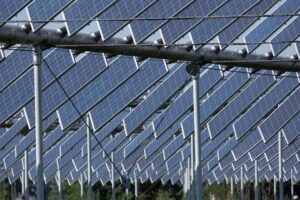As discussions about climate change and solutions to solve the threat continue to increase, more and more individuals are becoming aware of the impact that humans are having on the environment. Many suggestions are being brought forth to try to mitigate the environmental effects of traditional fossil fuels that are being consumed rapidly in order for society to perform at the current pace, while simultaneously looking into the future of green energy such as solar and wind power.
A leading argument against green energy such as solar and wind is that it comes at the cost of precious agricultural land, trading America’s breadbasket for cleaner energy. This dichotomy has proven to be a very divisive blockade for the green movement and has been a huge hurdle for environmentalists to overcome. Fortunately, as the need for change has grown exponentially a modern solution has been brought to the table.
Agrivoltaics
In an effort to reduce greenhouse emissions while also protecting vitally important farmland ecologists have delivered a solution designed to meet both issues head on. Agrivoltaics refers to the practice of raising up solar arrays to utilize the ground underneath for agricultural activity, whether growing consumables or resting arable land for the lifespan of the array to enable soil health. By raising solar panel arrays ecologists have discovered that farmland and solar energy can now be mutually beneficial. Not only will rural areas now have more access to clean energy, but farmland will continue to flourish beneath by allowing growing and grazing to commence without reduction in usable space. Not only will rural areas benefit from the increased clean energy output by delivering an abundance of electricity for things like electronic vehicle charging stations where demand continues to grow, but the local environment and soil are expected to react positively as well.
By adding solar panels to farmland, soil will receive a much-needed rest from the harsh open landscape that often punishes topsoil by overexposure to sunlight. By providing shade for a portion of the day, topsoil, pollinators and the microbes that inhabit it will begin to flourish in a cooler environment. In water-limited areas these benefits could make a drastic difference in the amount of water consumption needed while also reducing the amount of fertilizers required for a high crop yield. Farmers could in turn see an increase in revenue stream by reducing the amount of resources per acre. Researchers at Oregon State University back up this claim in a recent article Solar Panels + Agriculture: You Ain’t Seen Nothing Yet describing how solar arrays can create a cooling microclimate that enhances the environment for various crops. They also gathered evidence that the same cooling effect improves the efficiency of the solar panels.

An obvious benefit to the increased vitality of agricultural land is the increased productivity of the food supply. With the burdensome demand to feed growing populations food productivity is now more important than ever. Increasing soil health while reducing the amount of resources means not only increases producers revenue like mentioned before, it also results in a more abundant food supply at a more affordable price.
To incentivize the use of agrivoltaics the U.S. Department of Energy (DOE) announced recently that $8 million will be awarded to six solar energy research projects across six states and the District of Columbia that will provide new economic opportunities for farmers, rural communities, and the solar industry. This grant seeks to grow a partnership with agriculture and green energy production given the DOE’s findings that In the United States less than 2% of solar energy projects are co-located with crops or pollinator habitats. “DOE’s research into agrivoltaics provides an incredible opportunity to pair solar energy generation with safe and robust crop production—ensuring rural communities reap the full economic benefits of a clean energy future,” said U.S. Secretary of Energy Jennifer M. Granholm.
How Amatrol Can Help:
With more than 30 years of experience designing and manufacturing state-of-the-art training systems, Amatrol remains the world’s leader in skills-based, interactive technical learning for industry and education. What sets Amatrol apart is its dedication to providing comprehensive training solutions that integrate in-depth multimedia eLearning curriculum with hands-on trainers that feature real-world industrial components.
Amatrol is committed to improving the environment and we offer a variety of highly sophisticated interactive green energy trainers designed and built to train the next generation of workers in the green energy sector.
Citations:
-
Agrivoltaics Goes Nuclear On California Prairie
-
Experts root for agrivoltaics to solve clean energy, agricultural needs
-
DOE Announces $8 Million to Integrate Solar Energy Production with Farming





